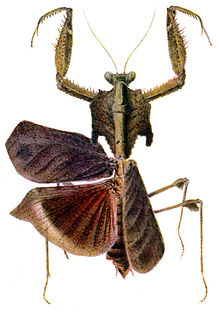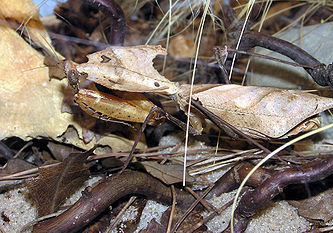- Deroplatys desiccata
-
Deroplatys desiccata 
Scientific classification Kingdom: Animalia Phylum: Arthropoda Class: Insecta Order: Mantodea Family: Mantidae Genus: Deroplatys Species: D. desiccata Binomial name Deroplatys desiccata
Beier, 1935Deroplatys desiccata, known by the common names Giant Dead Leaf Mantis and (less-frequently) Malaysian Dead Leaf Mantis, is a species of praying mantis from Southeast Asia.[1]
Contents
Description
D. desiccata takes its common name from its resemblance to dead, leafy vegetation including having a flattened, greatly extended thorax and "intricate leaf patterns" on its wings.[2][3] This insect varies in color from mottled brown through "pale orangey brown" to a very dark brown that is almost black.[4]
This creature's camouflage is aided by its movements as well as its appearance. When disturbed, it rocks gently as if caught in the breeze. When threatened, it typically falls to the ground and lies motionless.[4][5][6][7] It can also react with a threatening display consisting of "black underwings splayed out, with large eyespots, frightening away unsuspecting predators."[8]
As its common name indicates, D. desiccata is larger than other species of Dead Leaf Mantis. Females grow to 15 cm long. Displaying the sexual dimorphism typical of mantises, males grow only 6 cm long and are substantially smaller and lighter than females.[4][5][9] Females’ prothorax shields end in a sharp pointed curve on each side while the males have a rounder shape. According to one source, males tend to be more "yellowish" than the darker females.[1]
Diet
Like most mantises, this species has little or no food preferences as long as the prey is the right size, but one source does observe that they "especially love flying insects like moths." [4]
Range
D. desiccata inhabits scrubland and forests in Borneo, Indonesia, Malaysia, and Sumatra.[5][9]
Cultivation
 Deroplatys desiccata photographed at Bristol Zoo in 2007
Deroplatys desiccata photographed at Bristol Zoo in 2007
One insect hobbyist and breeder calls this species:
The undisputed king of the Dead-leaf Mantids! D. desiccata is the largest Dead-leaf Mantid- a group of mantids whose coloration and wing patterns closely mimic (what else?) dead leaves...If size and power is what makes for your perfect mantid, this is definitely one species to consider. It's also one of the easier species of mantids to raise in captivity.[10]
A second breeder of insects recommends as a diet that:
Babies eat flightless fruit flies, pinhead crickets, and other small insects. Adults eat crickets, moths, flies, flour worms, and other large insects.[9]
The same source says they "should be kept at 75° - 80°F, and 75% damp" and that "They are docile and calm." [9]
While a third breeder assures potential owners that breeding this exotic species "is generally simple" and says "All in all, I would recommend this species to anyone"[11] another cautions that this species requires a little more heat than many other mantises kept as pets and that it is best to keep their enclosure at a temperature of around 30 C (86 F) through the use of a heat mat or heat lamp if needed. The same breeder recommends keeping D. desiccata's cage at a cooler temperature at night to lengthen their life expectancy. A constant 70–80% humidity is also recommended.[1]
See also
References
- ^ a b c [1] mantisphotos.com: Malaysian Dead Leaf Mantis
- ^ [2] mantiskingdom.com: Dead Leaf Mantis D. Desiccata
- ^ [3] Tree of Life Web Project. Deroplatys desiccata. Version 14 March 2006
- ^ a b c d [4] Species of mantids: Dead Leaf Praying Mantid
- ^ a b c [5] Dead exotic-pets.co.uk: Leaf Praying Mantis
- ^ [6] shearyadi.com: Greatest animals camouflage
- ^ [7] animalpicturesarchive.com: Dead Leaf Mantis (Deroplatys desiccata) camouflage
- ^ [8] bugsincyberspace.com: Deroplatys desiccata
- ^ a b c d [9] Phasmids in Cyberspace: Deroplatys dessicata
- ^ [10] Bugs in Cyberspace: Deroplatys desiccata
- ^ [11] mantiskingdom.com: Dead Leaf Mantis D. desiccata
Categories:- Deroplatys
- Insects of Asia
- Fauna of Borneo
- Insects of Indonesia
- Invertebrates of Malaysia
- Sumatra
- Animals described in 1935
Wikimedia Foundation. 2010.
